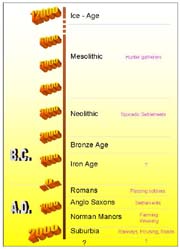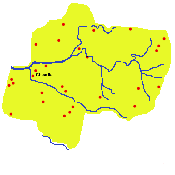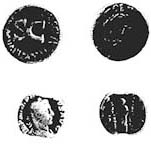Cheadle Hulme |
. | . | History - Early |
"In prehistoric times our forefathers, clad in
skins, roamed over the marshes, the moors, and the woods, where Cheadle now stands, and
the only traces of them that are left to tell the tale are their weapons of war .."
|
8000-3500 BC (Mesolithic) A possible microlith was unearthed in Cheadle Hulme in the 1990s. |
3500-2000 BC
(Neolithic) Further archaeological finds in Cheadle village, including an axe-hammer and urn confirm settlement in the early Bronze Age. Burial sites have been located elsewhere in the borough. Prehistoric
Cheadle Hulme |
1200 BC-70 AD 70-500 AD
(Roman Rule) However, in addition to a Roman road from Manchester to Buxton (similar to the A6) there is some suggestion of a Roman road from Cheadle (or possibly Manchester) to Buxton running along Cheadle Road (Street Road) through modern Cheadle Hulme, along Ack Lane East and through Bramhall, Woodford (Walnut Tree Farm), and Pott Shrigley. Roman artefacts (coins, bracelets) discovered at Millington Hall, and Hulme Hall support this.
Presence of a Roman military site at Castle Hill in Stockport is still debatable, however numerous finds of Roman coins in the Cheadle area and a quernstone at Bramhall Green & Siddal House suggest some Roman activity along the Lady Brook valley and edge of Kitt's Moss. |
|
Adapted from Arrowsmith, 1997, Chapter 2 | ||



